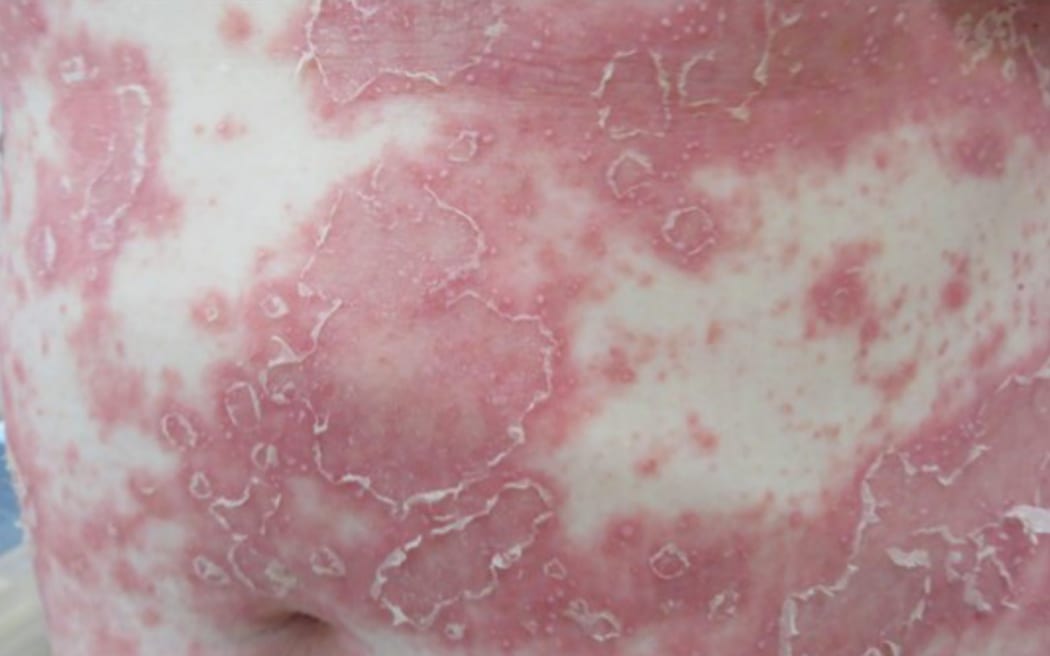
There's only one public dermatologist working in Palmerston North Hospital. Photo: Jimmy Ellingham, RNZ
A woman in her 20s who suffered a skin reaction from her epilepsy medication nearly died after waiting weeks to see a dermatologist in the public system.
Dr Hyun Kyoung Lee - who analysed the case for The New Zealand Medical Journal - said it was believed to be the first documented case in the world of Lamotrigine-induced generalised pustular psoriasis.
Lamotrigine is prescribed for a range of conditions, including epilepsy and mood disorders.
In this case, the patient noticed a rash on her feet within a week of starting on the medication.
Her GP prescribed antibiotics, steroids, antifungals and antihistamines - but the vivid red rash kept spreading until it covered half her body and the skin started peeling away.
It took six weeks to diagnose.
"During those six weeks, the GP tried to refer her to the public dermatology service, but there's only one public dermatologist working in Palmerston North Hospital and I think she only works two half-days a week, so the waiting list is quite long," Dr Lee said.
"The patient was waiting for the public dermatologist for several weeks without any luck."

The abdomen shows a patchy and confluent erythematous rash studded with fine pseudo-pustulosis and peeling. Photo: Screenshot / New Zealand Medical Journal
New Zealand has fewer than 80 dermatologists of whom the equivalent of just 22 work full-time in the public system. Some regions have none.
Te Whatu Ora MidCentral said the current wait time to see its dermatologist was 94 days - but urgent cases would be seen outside regular hours.
In this case, the worried GP referred the patient to a private dermatologist Louise Reiche, who immediately had her admitted to hospital.
Dr Reiche, who is also co-president of the Dermatological Society, said the case required coordination with other specialists, including neurologists.
"That's because epilepsy treatments can't be stopped precipitously without a risk of causing quite dangerous, prolonged epilepsy flares."
She described it as "a tightrope situation".

Dermatological Society co-president Louise Reiche. Photo: Supplied / NZ Dermatological Society
"Had there been a further delay of a couple of days or even a day, that patient would have been a mortality statistic."
The report found the delay in getting a specialist appointment put the woman's life at risk.
"This patient had not been able to seek timely public hospital dermatology clinic review, due to New Zealand health service pressures, resulting in disease progression and subsequent need for admission."
In the five years to the end of December, Medsafe recorded 710 adverse reactions from lamotrigine, including six deaths.
A second young woman taking Lamotrigine spent a month in Palmerston North Hospital late last year after she developed Stevens-Johnson Syndrome, a life-threatening skin condition affecting one or two in a million people each year.
The drug safety agency said the level was in line with international reporting, with more than 17,000 New Zealanders prescribed the drug last year.
However, doctors warned other patients were at risk from complications because of long waits to see specialists.
Auckland dermatologist Paul Jarrett said too many patients ended up in hospital because they did not get earlier treatment for their skin conditions.
"We know there are interventions that can help, we just need the workforce to be able to provide it and the funding to provide it as well.
"It doesn't sit easily on any doctor's shoulders not to provide the best care available. It's deeply uncomfortable."
Dr Jarrett, who is the Dermatological Society's spokesperson on public provision, said this country only had one dermatologist for every 250,000 people.
The ideal ratio was one dermatologist per 80,000.
"The private as well as the public, all of us are running like hamsters on the wheel."





